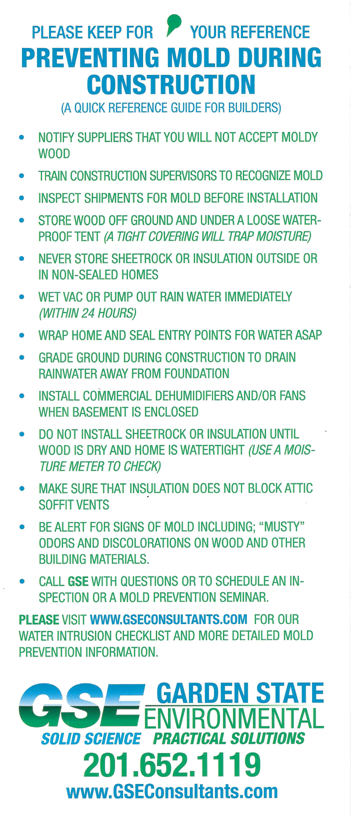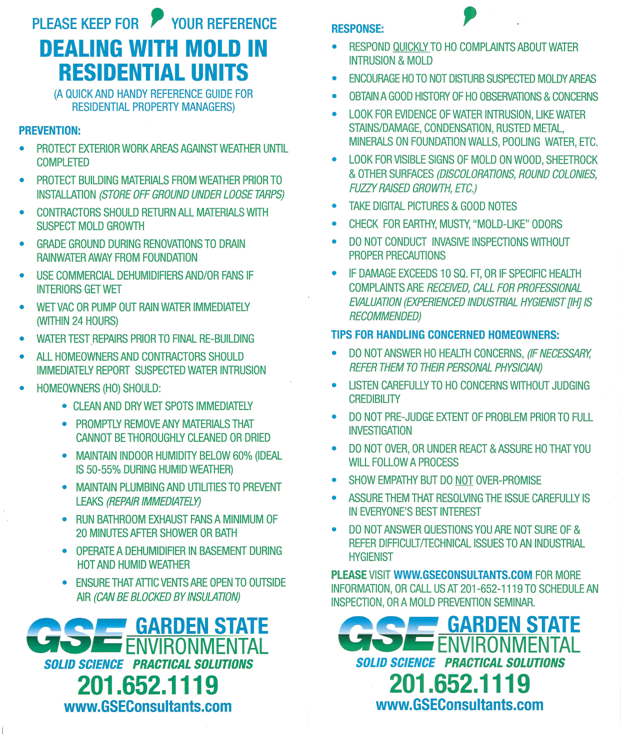Ignoring Mold Can Come Back To Haunt You...
As we get into the 2018 spring construction (and wet) season, mold continues to be a concern to builders and their customers. Smart builders know that mold growth will scare away potential buyers, delay closings and increase costs. Prospective buyers do not want to take the chance that mold will affect the health of their families and reduce the resale value of their homes. These concerns have not gone away and only get worse (and more expensive) if ignored.
This article is designed to give you a refresher on mold including the truth about the health effects of mold exposure, the best ways to prevent problems and how to properly respond to keep a small issue from becoming a big problem.
The information is based on GSE’s extensive research and experience with over 10,000 water intrusion and mold cases over the past 15 years. Much of our work has been for residential builders, construction companies, property management companies and attorneys (who generally only get involved when the responsible parties do not properly handle suspected mold conditions).
Q - Mold has been around forever – Why is it such an important issue lately?
A - Many older buildings were constructed of masonry and hardwoods with minimal insulation. Such buildings were less susceptible to mold since the materials were harder for molds to grow on and as air and moisture moved in and out, building materials tended to dry faster. Newer buildings are more energy efficient, which also serves to trap in moisture (and indoor air contaminants) and reduce fresh air, leading to higher risk for microbial growth. In addition, modern building practices often involve pre-fabricated truss and wall assemblies that can sit exposed to the elements during transportation, staging and in place prior to roof and siding installation. Medical science has also learned a lot about the health effects of molds in recent years, although there is still much research to be done.
Q - What exactly is mold?
A - Molds are living organisms in the Kingdom Fungi. They mostly come from the outdoors from trees and other vegetation, but mold is found almost everywhere. Molds grow best in warm, damp, and humid conditions, and spread and reproduce by producing spores which are microscopic, tough and can float in the air for long periods of time. This fact is especially important in buildings with forced air duct systems which can help spread mold spores throughout the building. No one knows how many species of mold exist but it is estimated that there are “hundreds of thousands”. Mold can grow on virtually any organic substance, which means most common household and building materials are susceptible, including wood, paper, wallboard (sheetrock), insulation, clothing, leather good, carpets and foods.
Q – Can mold really make you sick? What are the major known health effects from mold exposure?
A - The best documented health effects are upper respiratory and “hay fever-like” symptoms such as cough, sneezing, headaches, tightness in the chest, scratchy throat, difficulty breathing, red and itchy eyes, etc. Science has also shown that mold exposure can cause asthma or make it worse in some people. Other medical studies suggest a link between mold exposure and lower respiratory issues such as bronchitis and emphysema. Despite media reports, we do not yet have proven medical evidence that environmental mold exposure causes other conditions such cancer, heart or skin diseases; studies are ongoing.
The duration of symptoms varies depending on the individual’s health status. In some cases, the health effects can be long lasting or life-long.
Q – Is all black mold toxic and dangerous? I’ve heard a lot about “toxic mold” and “black deadly mold” over the last few years - How concerned should I be?
A - Those alarming terms show up in the media on a regular basis. Some mold-related companies use them as “scare tactics” to frighten builders, homeowners, tenants and building owners into action. Such terms are not based on good science and are not useful in understanding the risks of mold exposure and making good decisions.
Your concern should be based on such factors as:
- Extent and location of the mold growth
- The source(s) of moisture
- Types of building materials impacted
- Medical status of occupants
- Occupancy patterns and activities
- Type and maintenance of heating and cooling systems
- The ambient environment
In general, the longer people are exposed to mold and the higher the levels of exposure, the greater the risk of negative health effects. The actual risks are difficult to determine and depend on the above factors and each individual’s immune response to the exposure. That is one of the key reasons that there are no government regulations or authoritative exposure limits for mold.
These groups of people have Increased risk of negative health effects from mold exposure:
- People with known mold or other outdoor allergies
- People with compromised immune systems
- People with chronic (especially respiratory system related) diseases
- The elderly and very young
- Those occupying chronically “damp” buildings
However, some healthy people can also develop sensitivity to mold and get sick from mold exposure.
Q - What should I do if I suspect mold during construction or immediately after?
A - Since mold control largely depends on moisture control, here are several helpful tips:
- Don’t panic! Not all wet building materials become moldy and not all mold conditions are serious.
- Don’t ignore possible signs of mold. Immediately look for possible sources of moisture without disturbing suspected mold (disturbance can spread microscopic mold spores into the air and around the building).
- Repair sources of water as soon as possible and dry the area quickly.
- Temporarily protect/seal the suspected moldy area by taping heavy gauge plastic over the area, being careful to leave a safe margin of at least 1 foot around the discolored area.
- Small areas (<10 sq. ft.) of visible mold on wallboard or other materials can usually be removed by a non-professional using basic precautions.
- If you find or suspect more than 10 sq. ft. of mold or smell “musty” or “earthy” odors but don’t see any water damage or leaks, consider the services of a professional Industrial Hygienist or Indoor Environmental Consultant. Such qualified professionals can evaluate the problem, test as needed and provide objective guidance on safely remediating the mold. CAUTION: To avoid a conflict of interest and potential rip-offs, the best source of objective advice is from a qualified consultant who is not also a mold contractor.
- Print out GSE's handy bulletin board reference guide titled, "DEALING WITH MOLD IN RESIDENTIAL UNITS." Post it on bulletin boards for quick access and use as part of employee training.
Q – What can I do to prevent mold?
A – Print out GSE's handy bulletin board reference guide titled, "PREVENTING MOLD DURING CONSTRUCTION.” Post it on bulletin boards for quick access and use as part of employee training.
Both reference guides are included below for your convenience.
Despite the best preventive efforts, water intrusion related damage and mold can happen. How you respond can make the difference between a small event and a major case involving health problems, expensive repairs or reconstruction, regulatory enforcement and possible litigation.
GSE has many years of experience in water intrusion, mold and other indoor our quality issues. Our team of experts is available to provide professional advice and assistance throughout NJ. Our practical experience and academic training allows us to give you state-of-the-art technical guidance that is balanced with real-life practical considerations.
Call for a free phone consultation and more information.


Home | Professional Services | Clients | About GSE | In the News | Contact Us | Resources | GSE Advisor
© Copyright 2026 Garden State Environmental, Inc. All Rights Reserved.
